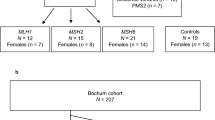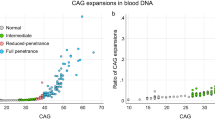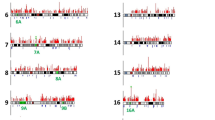Abstract
Huntington disease is associated with an unstable and expanded (CAG) trinucleotide repeat. We have analysed the CAG expansion in different tissues from 12 affected individuals. All tissues examined were found to display some repeat mosaicism, with the greatest levels detected in brain and sperm. Regions within the brain showing most obvious neuropathology, such as the basal ganglia and the cerebral cortex, displayed the greatest mosaicism, whereas the cerebellar cortex, which is seldom involved, displayed the lowest degree of CAG instability. In two cases of childhood onset disease we detected differences of 8 and 13 trinucleotides between the cerebellum and other regions of the brain. Our results provide evidence for tissue specific instability of the CAG repeat, with the largest CAG repeat lengths in affected regions of the brain.
This is a preview of subscription content, access via your institution
Access options
Subscribe to this journal
Receive 12 print issues and online access
$209.00 per year
only $17.42 per issue
Buy this article
- Purchase on Springer Link
- Instant access to full article PDF
Prices may be subject to local taxes which are calculated during checkout
Similar content being viewed by others
References
Harper, P.S. Huntington's Disease (Saunders, London, 1991).
Hayden, M.R. Huntington's Chorea (Springer-Verlag, New York, 1981).
Vonsattell, J-P. et al. Neurapathological classifcation of Huntington's disease. J. Neuropath. Exp. Neurol. 44, 559 – 677 (1985).
Huntington Disease Collaborative Research Group. A novel gene containing a trinucleotide repeat that is expanded and unstable on HD chromosomes. Cell 72. 971 – 983 (1983).
Kremer> et al. Worldwide distribution of the Huntington disease(HD) mutation: The sensitivity and specificity of CAG repeat length assessment. New Engl. J. Med. (in the press).
Mahadevan, M. et al. Myotonic dystrophy mutation: an unstable CTG repeat In the 3′ untranslated region of the gene. Science 255, 1253 – 1255 (1992).
Brook, J.D. et al. Molecular basis of myotonic dystrophy: expansion of a trinucleotide (CTG) repeat at the 3′ end of a transcript encoding a protein kinase family member. Cell 68, 799 – 808 (1992).
Fu, Y-H. et al. An unstable triplet repeat in a gene related to myotonic muscular dystrophy. Science 255, 1256 – 1258 (1992).
Oberle, I. et al. Instability of a 550-base pair DNA segment and abnormal methylation in fragile X syndrome. Science 252, 1097 – 1102 (1991).
Kremer, E.J. et al. Mapping of DNA instability at the fragile X to trinucleotide repeat sequence p(CCG)n. Science 252, 1711 – 1714 (1991).
Verkerk, A.J.M.H. et al. Identification of a gene (FMR-1) containing a CCG repeat co-incident with a breakpoint cluster region exhibiting length variation in fragile X syndrome. Cell 65, 905 – 914 (1991).
Fu, Y-H. et al. Variation of the CCG repeat at the fragile X site results in genetic instability: resolution of the Sherman paradox. Cell 67, 1047 – 1058 (1991).
LaSpada, A.R., Wilson, E.M., Lubahn, D.B., Harding, A.E. & Fishbeck, K.H. Androgen receptor gene mutations in X-linked spinal and bulbar muscular atrophy. Nature 352, 77 – 79 (1991).
Orr, H.T. et al. Expansion of an unstable trinucleotide CAG repeat in spinocerebellar ataxia type 1. Nature Genet. 4, 221 – 226 (1993).
Knight, S.J.L. et al. Trinucleotide repeat amplification and hypermethylation of a CpG island in FRAXE mental retardation. Cell 74, 127 – 134 (1993).
Koide, R. et al. Unstable expansion of CAG repeat in hereditary dentatorubral-pallidoluysian atrophy (DRPLA). Nature Genet. 6, 9 – 13 (1994).
Nagafuchi, S. et al. Dentatorubral and pallidoluysian atrophy expansion of an unstable CAG trinucleotide on chromosome 12p. Nature Genet. 6, 14 – 18 (1994).
Andrew, S.E. et al. The relationship between trinucleotide (CAG) repeat length and clinical features of Huntington's disease. Nature Genet 4, 398 – 403 (1993).
Duyao, M. et al. Trinucleotide repeat length instability and age of onset in Huntington disease. Nature Genet. 4, 387 – 392 (1993).
Snell, R.G. et al. Relationship between trinucleotide repeat expansion and phenotypic variation in Huntington's disease. Nature Genet. 4, 393 – 397 (1993).
Zühlke, C. et al. Expansion of the (CAG)n repeat causing Huntington's disease in 352 patients of German origin. Hum. molec. Genet. 2, 1467 – 1469.
Nørrømqlle, A. et al. Trinucleotide repeat elongation in the Huntingtin gene in Huntington disease patients from 71 Danish families. Hum. molec. Genet. 2, 1475 – 1476.
Telenius, H. et al. Molecular analysis of juvenile Huntington disease: The major influence on (CAG)n repeat length is the sex of the affected parent. Hum. molec. Genet. 2, 1535 – 1540 (1993).
Myers, R.H. et al. De novo expansion of a (CAG)n repeat in sporadic Huntington's disease. Nature Genet. 5, 168 – 173 (1993).
Goldberg, Y.P. et al. Molecular analysis of new mutations for Huntington's disease: intermediate alleles and sex of origin effects. Nature Genet. 5, 174 – 179 (1993).
Strong, T.V. et al. Widespread expression of the human and rat Huntington's disease gene in brain and nonneuroal tissues. Nature Genet. 5, 259 – 265 (1993).
Li, S-H. et al. Huntington's disease gene (IT15) is widely expressed in human and rat tissues. Neuron 11, 985 – 993 (1993).
Goldberg, Y.P., Andrew, S.E., Clarke, L.A. & Hayden, M.R. A PCR method for accurate assessment of trinucleotide repeat expansion in Huntington disease. Hum. molec. Genet. 6, 635 – 636 (1993).
Blinkov, S.M. & Glezer, I.I. in The Human Brain in Figures and Tables. A quantitative handbook 416 – 417 (Plenum, New York, 1968).
Strand, M. et al Destabllization of tracts of simple repetitive DNA in yeast by mutations affecting DNA mismatch repair. Nature 365, 274 – 276 (1993).
Anvret, M. et al. Larger expansions of the CTG repeat in muscle compared to lymphocytes from patients with myotonic dystrophy. Hum. molec. Genet. 2, 1397 – 1400 (1993).
McDonald, M.E. et al. Gametic but not somatic instability of CAG repeat length in Huntington's disease. J. med. Genet. 30, 982 – 986 (1993).
Zühlke, C. et al. Mitotic stability and meiotic variability of the (CAG)n repeat in the Huntington disease gene. Hum. molec Genet. 2, 2063 – 2067 (1993).
Author information
Authors and Affiliations
Rights and permissions
About this article
Cite this article
Telenius, H., Kremer, B., Goldberg, Y. et al. Somatic and gonadal mosaicism of the Huntington disease gene CAG repeat in brain and sperm. Nat Genet 6, 409–414 (1994). https://doi.org/10.1038/ng0494-409
Received:
Accepted:
Issue Date:
DOI: https://doi.org/10.1038/ng0494-409
This article is cited by
-
Cell-type-specific CAG repeat expansions and toxicity of mutant Huntingtin in human striatum and cerebellum
Nature Genetics (2024)
-
Ferroptosis: underlying mechanisms and involvement in neurodegenerative diseases
Apoptosis (2024)
-
LUSTR: a new customizable tool for calling genome-wide germline and somatic short tandem repeat variants
BMC Genomics (2024)
-
Dynamic alternative DNA structures in biology and disease
Nature Reviews Genetics (2023)
-
The Role of Alleles with Intermediate Numbers of Trinucleotide Repeats in Parkinson’s Disease and Other Neurodegenerative Diseases
Neuroscience and Behavioral Physiology (2023)



